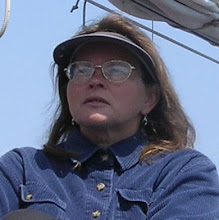
This image was submitted by Deborah Upton who is re-establishing roots on the Grand Manan and will have the reverse view of Swallowtail (southern side) from her new house on Net Point. This view is from Hole-in-the-Wall Park on the northern side of Swallowtail. She took this last summer.
It isn't difficult to see why this point of land had inspired so many and why so many people are passionate about it. As lighthouses have been destaffed and automated, most of the associated lightkeeper buildings have been removed or torn down. To be able to keep all of the buildings on Swallowtail intact is a challenge and also a wonderful opportunity to preserve a way of life that is disappearing very quickly but represents an important part of maritime history.
The view of Swallowtail is a bit different today with -12 C air temperature and strong northwest wind driving sea smoke or vapour up and over the lightkeepers house from the Sawpit. Sea smoke forms in the winter when the air temperature is significantly lower than the water temperature. It swirls and dances on the surface of the water and if cold enough, can be incredibly dense and forming banks of clouds. Around Grand Manan, the ocean does not freeze because of the strong tidal action keeping ice pans broken up and mixing warmer bottom water with surface water, although ice pans do form in sheltered areas where there is fresh water input and prolonged periods of cold weather.
A peculiar phenomenon occurred a few winters ago when the water temperature was at its coldest (usually March) and during a snow storm without strong winds, the snow actually accumulated on the surface of the water until the tidal action broke it up. The snow covered water had an almost gelatinous look to it.
